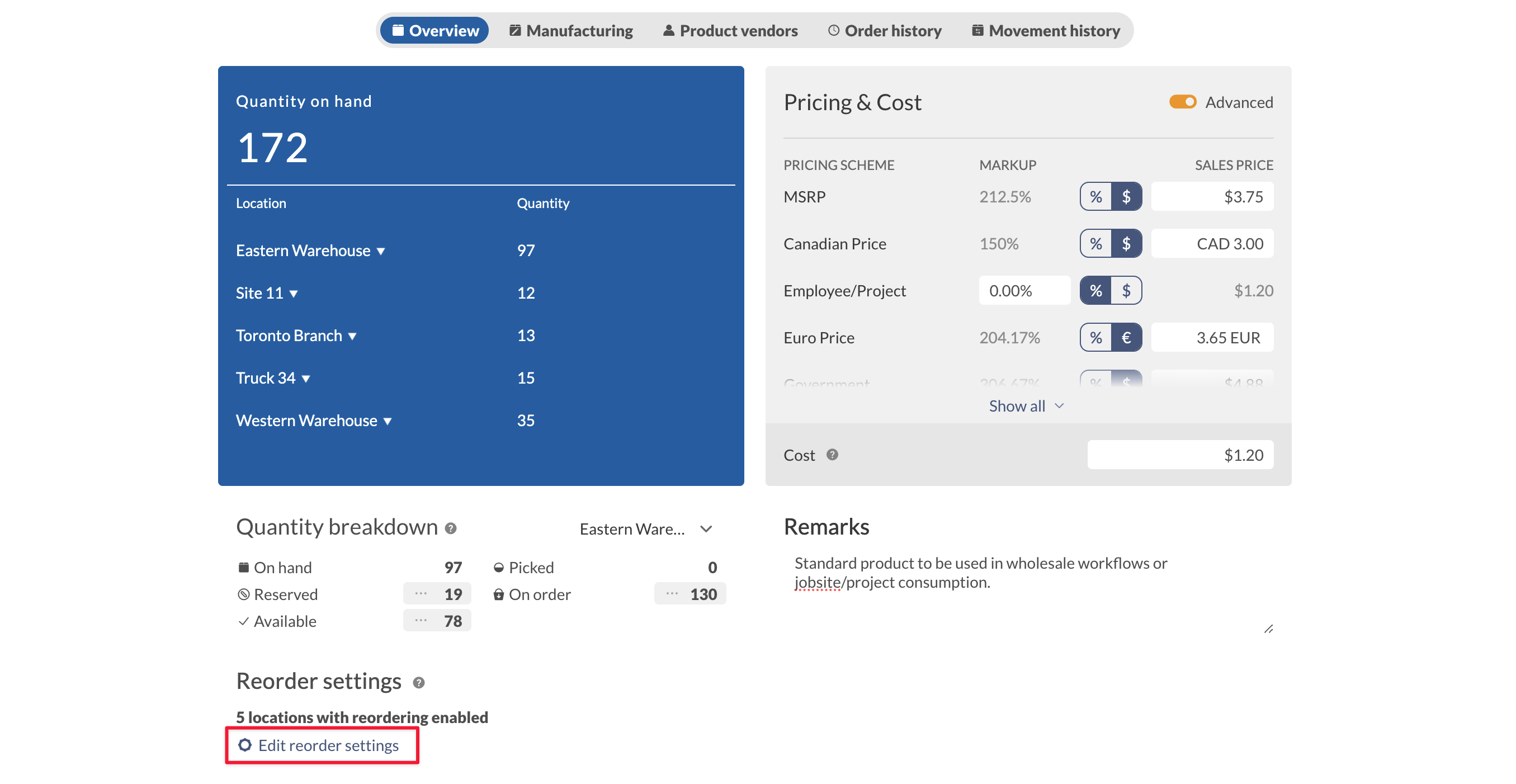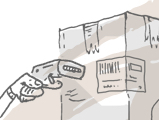How to setup product reordering
The Reorder Stock function in inFlow Cloud can help you reorder your stock when you need more inventory. You’ll need to set up your reorder points and quantities first before inFlow can reorder stock for you.
Web
Reordering video
inFlow Cloud for Web
What do “reorder point” and “reorder quantity” mean?
The reorder point field is the minimum level/point of your stock before you need to reorder more. So if you set a reorder point of 25, as soon as the stock level goes to 24 or lower, inFlow will suggest that you reorder it.
The reorder quantity field is how much stock you would like to reorder at a time. For example: if you always purchase the item in cases of 4 units, then you’ll want to put 4 in the Reorder Quantity field. inFlow will multiply the reorder quantity in the purchase order as needed to get you back above your reorder point.
To set up your reorder points/quantities:
- Go to Main Menu > Product List.
- Double-click on the product you want to add a reorder point for.
- Scroll to the Reorder Settings section and hit the Edit reorder settings button.
- Find the location you want to set up reordering for the item and toggle the off button to on by clicking it.
- Choose the method for how this item is restocked (Purchase Order, Stock Transfer, Work Order).
- In the Reorder Point field, enter the minimum point/limit your stock level would reach before reordering more.
- In the Reorder Quantity field, enter the amount to reorder at a time if the item needs to be restocked.
- Click done to exit the reorder setting window and then hit save to record your changes.
Once you’ve set up your reorder points and quantities, inFlow Cloud can notify you when you’re low in stock!

You can also check out the Recommended Reorder Point report that can suggest a reorder point for your products.
If I have an item that I order in sets of 4, I would want inFlow to always order at least 4 (reorder quantity) when I reorder. Let’s say I want to have at least 25 in my warehouse at all times (reorder point). So I would set up my reorder points and reorder quantities as above.
As the reorder point is 25, it will ask me to reorder as much as possible to get back to 25 or above. So for example: if the stock level was 10, the system would look at the difference between that and your reorder point (25-10 = 15). Since we have a reorder quantity of 4, it must use multiples of 4 to get you back up to 25 or above. So instead of ordering 15, it orders 16 (i.e. 4×4).
To reorder many products at once:
- Main Menu > Inventory > Reorder Stock.
- Select the location you are reordering for.
- Review the list and select any vendors where necessary. When you’re ready click Reorder to automatically generate your Purchase Orders (split by Vendor).
How can I review orders/transfers?
There is a new tab button after you press the reorder button. Pressing the button will open a new browser tab directly to the order/transfer.
For items that are restocked using work orders, the button will be greyed out as the option is currently not available on the inFlow Cloud for Web. To review those orders you will have to open them up from the inFlow Cloud for Windows app.
How should I set up my reorder points/ quantities for items?
Generally, you would want to set your reorder point to a level where you can still fulfill incoming orders. You should plan this with how long it takes for your vendor to send you the stock. It’s also a good idea to set a large reorder quantity so you don’t keep sending out purchase orders too often.
However, there may be some special cases where this doesn’t apply. For example, products that you don’t keep in stock, but only order when necessary. You may also have the stock you only want to keep exactly at or just above the reorder point.
- To have inFlow reorder items up to just slightly above the reorder point, set your reorder quantity to a low number (3, or 4).
- To have inFlow reorder items up to exactly the reorder point, set your reorder quantity to 1.
Why isn’t my product showing up in the Reorder Stock window?
If you don’t see your product listed here, it could be that your current anticipated quantity is higher than your reorder point. Common reasons would include:
- you’ve already got a purchase order/work order incoming (quantity on order) for this product so you don’t have to reorder more
Current Anticipated Quantity
The reorder stock screen also lists the Current Anticipated Quantity for your items. This number is determined by what you’d have in stock if all your sales and purchases were completed now.
When your current anticipated quantity is lower than your reorder point, inFlow will suggest that you reorder more stock. For more information on how the current anticipated quantity is calculated please take a look at this article.
How should I set up my reorder points/ quantities for items I don’t stock?
Generally, you would want to set your reorder point to a level where you can still fulfill incoming orders. You should plan this with how long it takes for your vendor to send you the stock. It’s also a good idea to set a large reorder quantity so you don’t keep sending out purchase orders too often.
However, there may be some special cases where this doesn’t apply. For example, products that you don’t keep in stock, but only order when necessary. You may also have the stock you only want to keep exactly at or just above the reorder point.
- To have inFlow reorder items up to just slightly above the reorder point, set your reorder quantity to a low number (3, or 4).
- To have inFlow reorder items up to exactly the reorder point, set your reorder quantity to 1.
Why isn’t my product/vendor showing up in the Reorder Stock window?
If you don’t see your product listed here, it could be that your current anticipated quantity is higher than your reorder point. Common reasons would include:
- you’ve already got a purchase order/stock transfer/work order incoming (quantity on order) for this product so you don’t have to reorder more
As for the vendor column, inFlow auto-selects the last vendor you purchased the item from. If you have multiple vendors for an item, this selection may change during each re-ordering. It’s best to review the list every time you reorder. A blank vendor field means that the item has never been ordered in any purchase order before.
Reordering webinar
Windows
inFlow Cloud for Windows
- What do reorder point and reorder quantity mean?
- How should I set up my reorder points/quantities for items I don’t stock / other special cases?
- Why isn’t my product showing up in the reorder stock window?
Reordering webinar
What do “reorder point” and “reorder quantity” mean?
The reorder point field is the minimum level/point of your stock before you need to reorder more. So if you set a reorder point of 25, as soon as the stock level goes to 24 or lower, inFlow will suggest that you reorder it.
The reorder quantity field is how much stock you would like to reorder at a time. For example: if you always purchase the item in cases of 4 units, then you’ll want to put 4 in the Reorder Quantity field. inFlow will multiply the reorder quantity in the purchase order as needed to get you back above your reorder point.
To set up your reorder points/quantities:
- Go to your product record.
- Click the Edit reorder settings button to open up a new screen.
- Find the location you want to set up reordering for the item and toggle the off button to on by clicking it.
- Choose the method for how this item is restocked (Purchase Order, Stock Transfer, Work Order).
- In the Reorder Point field, enter the minimum point/limit your stock level would reach before reordering more.
- In the Reorder Quantity field, enter the amount to reorder at a time if the item needs to be restocked.
- Click ok to exit the reorder setting window and then hit save to record your changes.
Once you’ve set up your reorder points and quantities, inFlow Cloud can notify you when you’re low in stock!
For example:
If I have an item that I order in sets of 4, I would want inFlow to always order at least 4 at a time (reorder quantity) when I reorder. Let’s say I want to have at least 25 in my warehouse at all times (reorder point). I would set up my reorder points and reorder quantities as above.
As the reorder point is 25, it will ask me to reorder as much as possible to get back to 25 or above. So for example: if the stock level was 5, the system would look at the difference between that and your reorder point (25-5 = 20). Since we have a reorder quantity of 4, it must use multiples of 4 to get you back up to 25 or above (eg. 4×6).
To reorder:
- Go to Main Menu > Inventory > Reorder Stock.
- Select the location you are reordering for.
- Review the list and select any vendors where necessary. When you’re ready click Reorder to automatically generate your Purchase Orders (split by Vendor).
How can I review orders/transfers?
There is a new tab button after you press the reorder button. Pressing the button will open a new browser tab directly to the order/transfer.
Current Anticipated Quantity
The reorder stock screen also lists the Current Anticipated Quantity for your items. This number is determined by what you’d have in stock if all your sales and purchases were completed now.
When your current anticipated quantity is lower than your reorder point, inFlow will suggest that you reorder more stock. For more information on how the current anticipated quantity is calculated please take a look at this article.
How should I set up my reorder points/ quantities for items I don’t stock?
Generally, you would want to set your reorder point to a level where you can still fulfill incoming orders. You should plan this with how long it takes for your vendor to send you the stock. It’s also a good idea to set a large reorder quantity so you don’t keep sending out purchase orders too often.
However, there may be some special cases where this doesn’t apply. For example, products that you don’t keep in stock, but only order when necessary. You may also have the stock you only want to keep exactly at or just above the reorder point.
- To have inFlow reorder items up to just slightly above the reorder point, set your reorder quantity to a low number (3, or 4).
- To have inFlow reorder items up to exactly the reorder point, set your reorder quantity to 1.
Why isn’t my product/vendor showing up in the Reorder Stock window?
If you don’t see your product listed here, it could be that your current anticipated quantity is higher than your reorder point. Common reasons would include:
- you’ve already got a purchase order/stock transfer/work order incoming (quantity on order) for this product so you don’t have to reorder more
As for the vendor column, inFlow auto-selects the last vendor you purchased the item from. If you have multiple vendors for an item, this selection may change during each re-ordering. It’s best to review the list every time you reorder. A blank vendor field means that the item has never been ordered in any purchase order before.




0 Comments